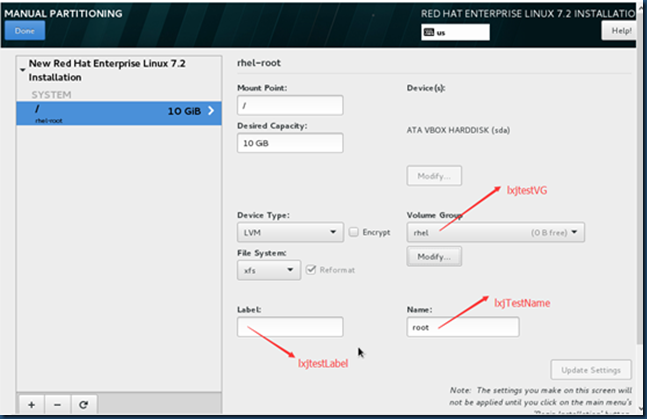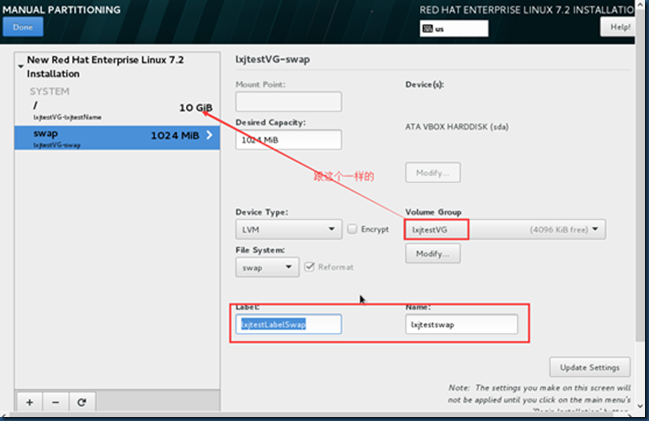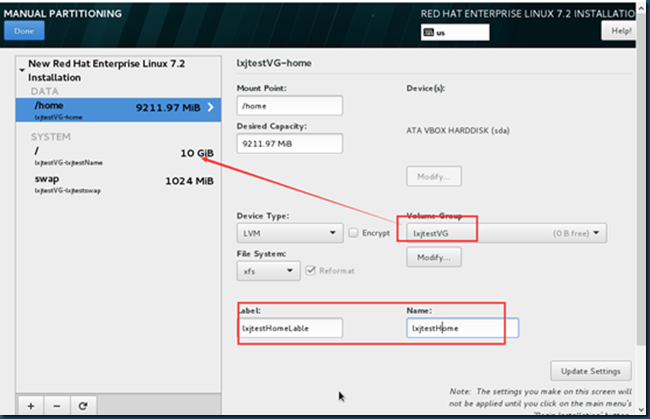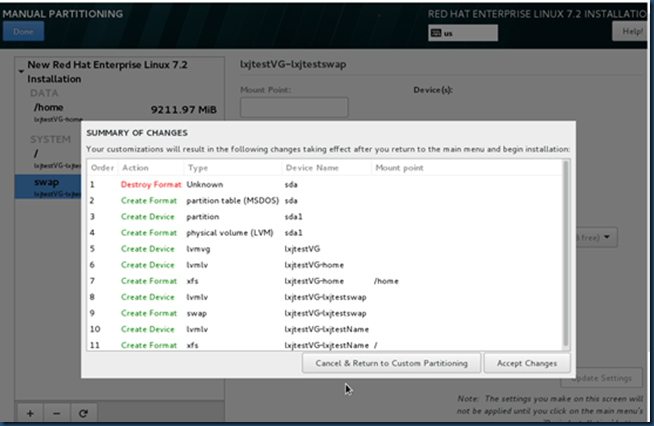LVM-Logical Volume Manager逻辑卷管理的一些基本概念:
用途:
在零停机前提下可以自如对文件系统的大小进行调整,可以方便实现文件系统跨越不同磁盘和分区。
当系统添加了新的磁盘,通过LVM机制,管理员就不必将磁盘的文件移动到新的磁盘上以充分利用新的存储空间,而是直接扩展文件系统跨越磁盘即可。
基本术语:
物理卷pv(Physical Volume)
物理卷就是指硬盘分区或从逻辑上与磁盘分区具有同样功能的设备(如RAID),是LVM的基本存储逻辑块,
但和基本的物理存储介质(如分区、磁盘等)比较,却包含有与LVM相关的管理参数.
●卷组vg(Volume Group)
卷组由物理卷组成,类似于非LVM系统中的物理硬盘,可以在卷组上创建一个或多个"LVM分区"(逻辑卷).
●逻辑卷lv(Logical Volume)
LVM的逻辑卷类似于非LVM系统中的硬盘分区,在逻辑卷之上可以建立文件系统(比如/home或者/usr等).
●PE(Physical Extent)
每一个物理卷被划分为称为PE(Physical Extents)的基本单元,具有唯一编号的PE是可以被LVM寻址的
最小单元.PE的大小是可配置的,默认为4MB.
●LE(Logical Extent)
逻辑卷也被划分为被称为LE(Logical Extents) 的可被寻址的基本单位.在同一个卷组中,LE的大小和
PE是相同的,并且一一对应.
和非LVM系统将包含分区信息的元数据保存在位于分区的起始位置的分区表中一样,逻辑卷以及卷 组相关的元数据也是保存在位于物理卷起始处的VGDA(卷组描述符区域)中.VGDA包括以下内容: PV描述符、VG描述符、LV描述符、和一些PE描述符 .
系统启动LVM时激活VG,并将VGDA加载至内存,来识别LV的实际物理存储位置.当系统进行I/O操作 时,就会根据VGDA建立的映射机制来访问实际的物理位置.
===========================
Creating LVM logical volumes involves creating the three layers in the LVM architecture. You first have to take care of the physical volume (PV), then you need to create the volume group (VG) and assign physical volumes to it. As the last step, the logical volume (LV) itself has to be created. In this section, you learn what is involved in creating these three layers. Different utilities exist for creating LVM. This chapter focuses on using the command-line utilities. They are relatively easy to use, and they are available in all environments (whether you are running a graphical interface or not). 顺序:PV--->VG--->LV
TIP You absolutely do not need to learn the commands discussed in this chapter by heart. All you really need to remember is pv , vg , lv . Open a command line, type pv and press the Tab key twice. This will show all commands that start with pv, which are all commands that are used for managing physical volumes. After you have found the command you need, run this command with the --help option. This shows a usage summary that lists everything that needs to be done to create the element you need.
一、Creating the Physical Volume --创建物理卷PV
In this exercise, you create a physical volume. To do this exercise, you need a hard disk that has free (unpartitioned) disk space available. The recommended method to make disk space available is by adding a new hard disk in your virtual machine environment. In this exercise, I use a clean /dev/vdb device to create the partition. You may have to change the device name to match your configuration. If you do not have a dedicated hard disk available to create this configuration, you might want to consider attaching a USB key to your machine. (我用的是Oracle VirtulBox虚拟机,添加一块虚拟磁盘用于测试)
1. Open a root shell and type fdisk /dev/sdc .
2. Type n to create a new partition. Select p to make it a primary partition, and use the partition number that is suggested as a default. If you are using a clean device, this will be partition number 1.
3. Press Enter when asked for the first sector and type +100M to accept the last sector.
4. Once you are back on the fdisk prompt, type t to change the partition type. Because there is one partition only, fdisk does not ask which partition to use this partition type on. You may have to select a partition if you are using a different configuration.
5. The partitioner asks for the partition type you want to use. Type 8e . Then, press w to write changes to disk and quit fdisk.
If you are getting a message that the partition table could not be updated while writing the changes to disk, reboot your system.
(首先,你得有一块未分区有磁盘,然后在这个磁盘上创建一个LVM类型的分区; 之后再为创建物理卷PV)
- fdisk -l查看分区情况:可以看到此时的/dev/sdc是没有分区的。
Disk /dev/sdc: 5368 MB, 5368709120 bytes, 10485760 sectors Units = sectors of 1 * 512 = 512 bytes Sector size (logical/physical): 512 bytes / 512 bytes I/O size (minimum/optimal): 512 bytes / 512 bytes Disk label type: dos Disk identifier: 0x0c16d904 Device Boot Start End Blocks Id System
- 为/dev/sdc磁盘分出一个区sdc1,大小为100M,类型为LVM
[root@rhel7 ~]# fdisk /dev/sdc Welcome to fdisk (util-linux 2.23.2). Changes will remain in memory only, until you decide to write them. Be careful before using the write command. Command (m for help): n Partition type: p primary (0 primary, 0 extended, 4 free) e extended Select (default p): p Partition number (1-4, default 1): First sector (2048-10485759, default 2048): Using default value 2048 Last sector, +sectors or +size{K,M,G} (2048-10485759, default 10485759): +100M Partition 1 of type Linux and of size 100 MiB is set Command (m for help): t Selected partition 1 Hex code (type L to list all codes): L 0 Empty 24 NEC DOS 81 Minix / old Lin bf Solaris 1 FAT12 27 Hidden NTFS Win 82 Linux swap / So c1 DRDOS/sec (FAT- 2 XENIX root 39 Plan 9 83 Linux c4 DRDOS/sec (FAT- 3 XENIX usr 3c PartitionMagic 84 OS/2 hidden C: c6 DRDOS/sec (FAT- 4 FAT16 <32M 40 Venix 80286 85 Linux extended c7 Syrinx 5 Extended 41 PPC PReP Boot 86 NTFS volume set da Non-FS data 6 FAT16 42 SFS 87 NTFS volume set db CP/M / CTOS / . 7 HPFS/NTFS/exFAT 4d QNX4.x 88 Linux plaintext de Dell Utility 8 AIX 4e QNX4.x 2nd part 8e Linux LVM df BootIt 9 AIX bootable 4f QNX4.x 3rd part 93 Amoeba e1 DOS access a OS/2 Boot Manag 50 OnTrack DM 94 Amoeba BBT e3 DOS R/O b W95 FAT32 51 OnTrack DM6 Aux 9f BSD/OS e4 SpeedStor c W95 FAT32 (LBA) 52 CP/M a0 IBM Thinkpad hi eb BeOS fs e W95 FAT16 (LBA) 53 OnTrack DM6 Aux a5 FreeBSD ee GPT f W95 Ext'd (LBA) 54 OnTrackDM6 a6 OpenBSD ef EFI (FAT-12/16/ 10 OPUS 55 EZ-Drive a7 NeXTSTEP f0 Linux/PA-RISC b 11 Hidden FAT12 56 Golden Bow a8 Darwin UFS f1 SpeedStor 12 Compaq diagnost 5c Priam Edisk a9 NetBSD f4 SpeedStor 14 Hidden FAT16 <3 61 SpeedStor ab Darwin boot f2 DOS secondary 16 Hidden FAT16 63 GNU HURD or Sys af HFS / HFS+ fb VMware VMFS 17 Hidden HPFS/NTF 64 Novell Netware b7 BSDI fs fc VMware VMKCORE 18 AST SmartSleep 65 Novell Netware b8 BSDI swap fd Linux raid auto 1b Hidden W95 FAT3 70 DiskSecure Mult bb Boot Wizard hid fe LANstep 1c Hidden W95 FAT3 75 PC/IX be Solaris boot ff BBT 1e Hidden W95 FAT1 80 Old Minix Hex code (type L to list all codes): 8e Changed type of partition 'Linux' to 'Linux LVM' Command (m for help): w The partition table has been altered! Calling ioctl() to re-read partition table. Syncing disks. [root@rhel7 ~]#
- fdisk -l 命令查看分区后的/dev/sdc
...略... Disk /dev/sdc: 5368 MB, 5368709120 bytes, 10485760 sectors Units = sectors of 1 * 512 = 512 bytes Sector size (logical/physical): 512 bytes / 512 bytes I/O size (minimum/optimal): 512 bytes / 512 bytes Disk label type: dos Disk identifier: 0x0c16d904 Device Boot Start End Blocks Id System /dev/sdc1 2048 206847 102400 8e Linux LVM .....略...
6. Now that the partition has been created, you need to flag it as an LVM physical volume.---分区创建完成后,可以使用命令partprobe使修改的分区生效,不用重启。
[root@rhel7 ~]# partprobe
To do this, type pvcreate /dev/sdc1 . You should now get this prompt: Physical volume “/dev/vbd1” successfully created.
7. Now type pvs to verify that the physical volume has been created successfully. The output may look like bellow .
[root@rhel7 ~]# pvcreate /dev/sdc1 WARNING: ext4 signature detected on /dev/sdc1 at offset 1080. Wipe it? [y/n]: y Wiping ext4 signature on /dev/sdc1. Physical volume "/dev/sdc1" successfully created [root@rhel7 ~]# pvs PV VG Fmt Attr PSize PFree /dev/sda2 rhel lvm2 a-- 19.51g 40.00m /dev/sdc1 lvm2 --- 100.00m 100.00m [root@rhel7 ~]#
As an alternative to the pvs command, which shows a summary of the physical volumes and their attributes, you can also use the pvdisplay command to show some more details.
pvdisplay命令:
[root@rhel7 ~]# pvdisplay --- Physical volume --- PV Name /dev/sda2 VG Name rhel PV Size 19.51 GiB / not usable 3.00 MiB Allocatable yes PE Size 4.00 MiB Total PE 4994 Free PE 10 Allocated PE 4984 PV UUID OjqvZk-KS1b-YegW-zb4b-uaNV-zGt7-npfsjU "/dev/sdc1" is a new physical volume of "100.00 MiB" --- NEW Physical volume --- PV Name /dev/sdc1 VG Name PV Size 100.00 MiB Allocatable NO PE Size 0 Total PE 0 Free PE 0 Allocated PE 0 PV UUID mf29mQ-wx2f-L94K-AFWH-rwA1-23oj-YE4yoV
二、Creating the Volume Groups --创建卷组VG
Now that the physical volume has been created, you can assign it to a volume group. It is possible to add a physical volume to an existing volume group , but you will now learn how to create a new volume group and add the physical volume to it.This is a simple one-command procedure. Just type vgcreate followed by the name of the volume group you want to create and the name of the physical device you want to add to it. So, if the physical volume name is /dev/sdc1, the complete command is vgcreate vgdata /dev/sdc1 (语法:vgcreate 卷组名 设备名). You are completely free in your choice of name for the volume group. I like to start all volume group names with vg, which makes it easy to find the volume groups if there are many, but you are free to choose anything you like.
After creating the volume group, you can request details about the volume group using the vgs command for a short summary, or the vgdisplay command to get more information.
[root@rhel7 ~]# vgcreate vgdate /dev/sdc1 Volume group "vgdate" successfully created [root@rhel7 ~]# vgs VG #PV #LV #SN Attr VSize VFree rhel 1 2 0 wz--n- 19.51g 40.00m vgdate 1 0 0 wz--n- 96.00m 96.00m [root@rhel7 ~]# vgdisplay --- Volume group --- VG Name rhel System ID Format lvm2 Metadata Areas 1 Metadata Sequence No 3 VG Access read/write VG Status resizable MAX LV 0 Cur LV 2 Open LV 2 Max PV 0 Cur PV 1 Act PV 1 VG Size 19.51 GiB PE Size 4.00 MiB Total PE 4994 Alloc PE / Size 4984 / 19.47 GiB Free PE / Size 10 / 40.00 MiB VG UUID RisrnE-lJIv-XM6h-47zQ-rsiU-JVP6-9ZexZO --- Volume group --- VG Name vgdate System ID Format lvm2 Metadata Areas 1 Metadata Sequence No 1 VG Access read/write VG Status resizable MAX LV 0 Cur LV 0 Open LV 0 Max PV 0 Cur PV 1 Act PV 1 VG Size 96.00 MiB PE Size 4.00 MiB Total PE 24 Alloc PE / Size 0 / 0 Free PE / Size 24 / 96.00 MiB VG UUID hNTqaY-c0Hi-v5wk-p7lQ-TIbc-oSpm-TIOcHs [root@rhel7 ~]#
In this procedure, you learned how to create a volume group in a two-step procedure where first the physical volume is created with the pvcreate command, after which the volume group is added using the vgcreate command. You can do this in a one-step procedure as well (where using a separate pvcreate command will not be necessary). If you are adding a partition to the volume group, however, it must be marked as partition type 8e already.
The one-step procedure is particularly useful for adding a complete disk device (which does not need to be marked as anything). If you want to add the disk / dev/ sdc, for instance, just type vgcreate vgdata /dev/sdc to create a volume group vgdata that contains the /dev/sdc device. When you are doing this to add a device that has not been marked as a physical volume yet, the vgcreate utility will automatically flag it as a physical volume. When creating volume groups, a physical extent size is used. The physical extent size defines the size of the building blocks used to create logical volumes. A logical volume always has a size that is a multiple of the physical extent size. If you need to create huge logical volumes, it is more efficient to use a big physical extent size. If you do not specify anything, a default extent size of 4.00 MiB is used. The physical extent size is always specified as a multiple of 2 MiB, with a maximum size of 128 MiB. Use the vgcreate -s option to specify the physical extent size you want to use.
NOTE When working with LVM, there is the physical extent size to consider. This is the size of the basic building blocks used in the LVM configuration. When working with an ext4 file system, logical extents are used. The extent size on LVM are in no way related to the extent sizes that are used on the file systems.
三、Creating the Logical Volumes and File Systems 创建逻辑卷和文件系统
Now that the volume group has been created, you can start creating logical volumes from it. This procedure is slightly more complicated than the creation of physical volumes or volume groups because there are more choices to be made. While creating the logical volume, you must specify a volume name and a size.
The volume size can be specified as an absolute value using the -L option. Use, for instance, -L 5G to create an LVM volume with a 5GB size. Alternatively, you can use relative sizes using the -l option. For instance, use -l 50%FREE to use half of all available disk space. You’ll further need to specify the name of the volume group that the logical volume is assigned to, and optionally (but highly recommended), you can use -n to specify the name of the logical volume. For instance, use lvcreate -n lvvol1 -L 100M vgdata to create a logical volume with the name lvvol1 and add that to the vgdata volume group.
[root@rhel7 ~]# vgs VG #PV #LV #SN Attr VSize VFree rhel 1 2 0 wz--n- 19.51g 40.00m vgdate 1 0 0 wz--n- 96.00m 96.00m [root@rhel7 ~]# lvcreate -n lvvol1 -L 100M vgdate Volume group "vgdate" has insufficient free space (24 extents): 25 required. [root@rhel7 ~]# lvcreate -n lvvol1 -L 90M vgdate Rounding up size to full physical extent 92.00 MiB Logical volume "lvvol1" created. [root@rhel7 ~]#
create file systems创建文件系统:
- At this point, you are ready to create a file system on top of the logical volume. Type mkfs.xfs /dev/vgdata/lvdata to create the file system.
- Type mkdir /lvmFiles to create a folder on which the volume can be mounted.
- Add the following line to /etc/fstab: ----开机自动挂载
/dev/vgdata/lvdata /lvmFiles xfs defaults 1 2
- Type mount -a to verify that the mount works and mount the file system.
[root@rhel7 ~]# mkfs.xfs /dev/vgdate/lvvol1 meta-data=/dev/vgdate/lvvol1 isize=256 agcount=4, agsize=5888 blks = sectsz=512 attr=2, projid32bit=1 = crc=0 finobt=0 data = bsize=4096 blocks=23552, imaxpct=25 = sunit=0 swidth=0 blks naming =version 2 bsize=4096 ascii-ci=0 ftype=0 log =internal log bsize=4096 blocks=853, version=2 = sectsz=512 sunit=0 blks, lazy-count=1 realtime =none extsz=4096 blocks=0, rtextents=0 [root@rhel7 ~]# mkdir /lvmFiles [root@rhel7 ~]# mount /dev/vgdate/lvvol1 /lvmFiles/ -手动挂载看看 [root@rhel7 ~]# df -h Filesystem Size Used Avail Use% Mounted on /dev/mapper/rhel-root 18G 4.5G 13G 26% / devtmpfs 911M 0 911M 0% /dev tmpfs 921M 0 921M 0% /dev/shm tmpfs 921M 8.4M 912M 1% /run tmpfs 921M 0 921M 0% /sys/fs/cgroup /dev/sda1 497M 124M 374M 25% /boot tmpfs 185M 0 185M 0% /run/user/0 /dev/mapper/vgdate-lvvol1 89M 4.8M 84M 6% /lvmFiles [root@rhel7 ~]#
添加到/etc/fstab,加下如一行,使其开机自动挂载:
/dev/vgdate/lvvol1 /lvmFiles/ xfs defaults 1 2
===============
LVM一些常用的命令:


步骤总结:
1.fdisk --磁盘分区为lvm类型(-t修改分区格式为8e、w写入分区表)
2.partprobe --让kernel重新读取分区表,使分区生效,无需重启系统
3.pvcreate /dev/sda1 ----创建物理卷PV
4.vgcreate VGname /dev/sda1 ---创建卷组VG,可以使用已经存在的VG名,把上一步创建的物理卷加入到这个VG里;一个VG可以包括多个PV.
5.lvcreate -n LVname -L 200MB VGname ---创建逻辑卷LV,要指定逻辑卷的名字LVname、大小以及从哪个卷组VG划分
6.mkfs.xfs /dev/VGname/LVname ---格式化逻辑卷LVname
7.mount /dev/VGname/LVname /lvmFiles ---mount挂载后就可以使用了
8.vi /etc/fstab --加入开机自动挂载即可
==============================================================
测试:这是在安装系统设置分区的过程中,创建PV、VG及LV的情况:
disk size:20GB
[root@rhel7Oracle ~]# pvs ---整个disk,共20GB作为一个PV PV VG Fmt Attr PSize PFree /dev/sda1 lxjtestVG lvm2 a-- 20.00g 0 [root@rhel7Oracle ~]# vgs ----创建了一个卷组VG:lxjtestVG VG #PV #LV #SN Attr VSize VFree lxjtestVG 1 3 0 wz--n- 20.00g 0 [root@rhel7Oracle ~]# lvs ----创建了三个逻辑卷:home,lxjtestName,lxjtestswap LV VG Attr LSize Pool Origin Data% Meta% Move Log Cpy%Sync Convert home lxjtestVG -wi-ao---- 9.00g lxjtestName lxjtestVG -wi-ao---- 10.00g lxjtestswap lxjtestVG -wi-ao---- 1.00g [root@rhel7Oracle ~]# pvdisplay --- Physical volume --- PV Name /dev/sda1 VG Name lxjtestVG PV Size 20.00 GiB / not usable 3.00 MiB Allocatable yes (but full) PE Size 4.00 MiB Total PE 5119 Free PE 0 Allocated PE 5119 PV UUID UIy2Bp-54uT-WUaz-fDo1-ljqd-u1uD-dlSpGn [root@rhel7Oracle ~]# vgdisplay --- Volume group --- VG Name lxjtestVG System ID Format lvm2 Metadata Areas 1 Metadata Sequence No 4 VG Access read/write VG Status resizable MAX LV 0 Cur LV 3 Open LV 3 Max PV 0 Cur PV 1 Act PV 1 VG Size 20.00 GiB PE Size 4.00 MiB Total PE 5119 Alloc PE / Size 5119 / 20.00 GiB Free PE / Size 0 / 0 VG UUID 2TbtUe-e34q-p36b-u9XA-OkfJ-EDvS-0Oel35 [root@rhel7Oracle ~]# lvdisplay --- Logical volume --- LV Path /dev/lxjtestVG/home LV Name home VG Name lxjtestVG LV UUID sOHWsQ-dsya-p1cM-p4no-pVPf-KX6g-E9SmsA LV Write Access read/write LV Creation host, time localhost, 2016-08-09 16:42:37 +0800 LV Status available # open 1 LV Size 9.00 GiB Current LE 2303 Segments 1 Allocation inherit Read ahead sectors auto - currently set to 8192 Block device 253:2 --- Logical volume --- LV Path /dev/lxjtestVG/lxjtestswap LV Name lxjtestswap VG Name lxjtestVG LV UUID OUroIn-GQih-o2zB-dHUO-qH1W-ahWb-bCJuQB LV Write Access read/write LV Creation host, time localhost, 2016-08-09 16:42:38 +0800 LV Status available # open 2 LV Size 1.00 GiB Current LE 256 Segments 1 Allocation inherit Read ahead sectors auto - currently set to 8192 Block device 253:1 --- Logical volume --- LV Path /dev/lxjtestVG/lxjtestName LV Name lxjtestName VG Name lxjtestVG LV UUID 2zpdZg-GFCo-NI6B-Kmfo-LjC5-jwYf-RZtcMA LV Write Access read/write LV Creation host, time localhost, 2016-08-09 16:42:38 +0800 LV Status available # open 1 LV Size 10.00 GiB Current LE 2560 Segments 1 Allocation inherit Read ahead sectors auto - currently set to 8192 Block device 253:0 [root@rhel7Oracle ~]#



